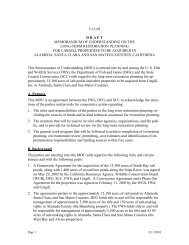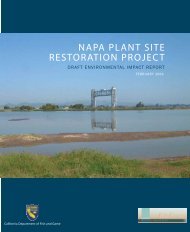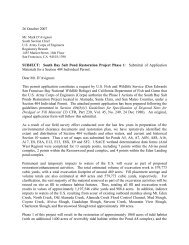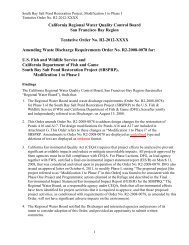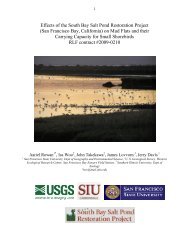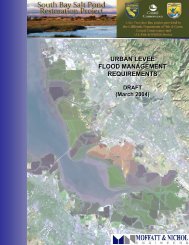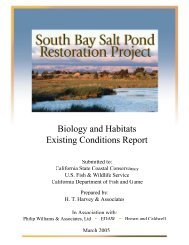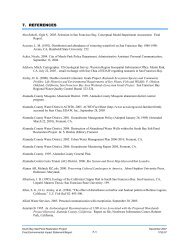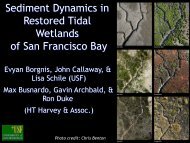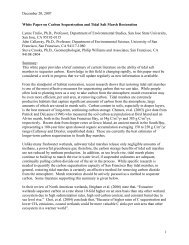M E M O R A N D U M - South Bay Salt Pond Restoration Project
M E M O R A N D U M - South Bay Salt Pond Restoration Project
M E M O R A N D U M - South Bay Salt Pond Restoration Project
Create successful ePaper yourself
Turn your PDF publications into a flip-book with our unique Google optimized e-Paper software.
7. ADAPTIVE MANAGEMENT DECISIONS<br />
Implementation of the later phases of any given program alternative will be subject to adaptive<br />
management based on feedback from on-going monitoring efforts of the earlier phases. Adaptive<br />
management can be used to adjust previously implemented actions as well as future actions to better meet<br />
the project objectives. As a result of these manipulations, the final implemented restoration plan will<br />
likely look different from the selected program-level alternative, but the objectives will be achieved.<br />
In each alternative, there are three types of decisions with respect to adaptive management.<br />
• “Irreversible” decisions, not subject to adaptive management once implemented. For example, levee<br />
alignment, infrastructure, marsh/transitional habitat locations, most public access structures<br />
• “Implemented” decisions subject to adaptive management. Early restoration actions that can be<br />
modified and/or adjusted after implementation. For example, pond water management plans,<br />
breaching (possibly), minor modifications to managed pond cell grading and trail alignments, and<br />
non-structural public-access/ recreation features<br />
• “Future” decisions subject to adaptive management. <strong>Restoration</strong> actions that have not yet been<br />
implemented that can be modified and/or adjusted prior to implementation. For example, aerial extent<br />
of tidal versus managed pond habitats needed to achieve the objectives, modifications to which ponds<br />
may be managed or tidal, locations and types of public access/recreation based on how people are<br />
responding<br />
For the preliminary program alternatives, there are three key areas of uncertainty for particular attention<br />
in adaptive management. The predictions referred to below will be developed during subsequent<br />
alternatives development and referenced in the adaptive management plan.<br />
1. Are the rates and patterns of tidal-habitat conversion occurring as predicted If not, adjust the<br />
locations and extent of tidal restoration to meet the objectives.<br />
2. Is bird use occurring as predicted If not, adjust the locations, extent, and types of managed ponds to<br />
meet the objectives.<br />
3. Are the rates, patterns, and environmental impacts of human recreation use occurring as predicted or<br />
do they cause adverse environmental impacts If the results are not occurring as predicted, adjust the<br />
locations, extents, and types of public-access/recreation features to meet the objectives.<br />
8. NEXT STEPS<br />
The next steps through mid-2005 will be to complete the landscape assessment of tidal-habitat evolution<br />
and bird use, evaluate the preliminary program alternatives using weighting and ranking, then to refine<br />
the preliminary program alternatives into final program alternatives for NEPA/CEQA assessment. The<br />
landscape assessment of tidal-habitat evolution and bird use will inform the weighting and ranking<br />
<strong>South</strong> <strong>Bay</strong> <strong>Salt</strong> <strong>Pond</strong> <strong>Restoration</strong> <strong>Project</strong> January 2005<br />
Preliminary <strong>Project</strong> Alternatives Memorandum 19 1750.01





